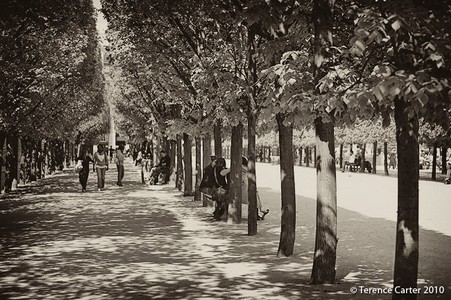在巴黎街头漫步 1)Strolling Paris' Passages and 2)Boulevards
文字难度:★★★
What makes walking in Paris so wonderful is wandering its grand boulevards and exploring its elegant 3)arcades. 4)Amble about for an hour and you'll understand how Paris gave birth to the 5)flâneur, a stroller fascinated with street life, for whom 6)sauntering the city was the best way to experience it.
行走于巴黎街头之所以让人心情如此愉悦,是因为你能够在它宽阔的林荫大道上闲庭信步,并一探其雅致的拱廊商街。只要漫步上一个小时,你就能明白为什么在巴黎街头会诞生“都市漫游者”,他们是一群痴迷于街头生活的漫步者,对于他们来说,徒步闲逛就是体验这个城市的最佳方式。
Depicted in the paintings of 7)Édouard Manet and the poetry of 8)Charles Baudelaire, and analysed exhaustively by 9)Walter Benjamin in The Arcades Project, the flâneur was considered “a botanist of the sidewalk” for whom shop windows merited as much attention as museum paintings.
这些都市漫游者不仅在爱德华·马奈的画作和夏尔·波德莱尔的诗篇中被描绘过,还在沃尔特·本雅明的著作《拱廊计划》中被全面透彻地分析过,他们被视为“街头植物学家”,对于他们来说,商店的橱窗同博物馆里的画作一样值得关注。
Now, while we have no interest in wearing10)cravats or 11)promenading turtles on 12)leashes, as the 13)flamboyant nineteenth century 14)dandies did, we've decided to take to the footpaths and passages of Paris to learn more about the city, and who better to guide us than our friend, Bernard?
如今,虽然我们对于像十九世纪浮华的花花公子们那样戴着男士领巾或牵着皮绳溜乌龟的行为毫无兴趣,我们也决定要到巴黎的人行小径和廊巷走走,深入了解这个城市;至于导游人选,则非我们的朋友贝尔纳莫属了。

We meet Bernard Zirnheld at Place Colette. Refreshingly, American-born Bernard is not a 15)Francophile, although he admits to having grown fond of the city. Holding degrees in French Literature and Fine Arts, he moved to Paris to do a doctoral 16)dissertation on architecture and urban planning. He is the ideal man to lead us on a17)mosey around the city.
我们在高莱特广场见到了贝尔纳·齐尔内尔德。出生于美国的他并不是一个“亲法”的人,这让我们感到有点意外,但他也承认自己越来越喜欢这座城市了。拥有法国文学和美术学位的他搬到巴黎来撰写关于建筑和城市规划的博士论文。他正是带领我们漫游这个城市的理想人选。
We begin on Rue de Rivoli, where, as we take in the elegant 18)edifices stretching all the way to Place de la Concorde, Bernard vividly sets the scene for the four of us doing his walk today: “Imagine: in 1801 Napoleon III wants to create a majestic boulevard, a uniform street of elegant 19)neoclassical 20)façades and arcades, a monumental setting for the Louvre; he wants very particular businesses and luxury shops and he goes as far as banning bakeries so there are no smells… this becomes Paris' first boulevard, intended as a ceremonial centre, inspired by Imperial Rome, that will connect important 21)nodes around the city…” Things start to make sense already.
我们从李维利大街开始,在那里我们看到一栋栋优雅的大型建筑一直延伸到协和广场,旁边的贝尔纳则绘形绘色地为今天随他而行的我们四人作背景介绍:“想象一下:在1801年,拿破仑三世想要修建一条宏伟的大道,一条风格统一,两旁全是优雅的具有新古典主义外立面和拱廊建筑的大道,作为卢浮宫的雄伟布景;他希望街道上都是精致特别的商家和高级奢华的店铺,他甚至还禁止面包店在那里经营,以防气味散逸其中……这就成为了巴黎的第一条大道,拿破仑三世想仿效罗马帝国将这里打造为庆典中心,并与整个城市的各个重要地点相连接……”一切已经开始变得明朗起来。
Ten minutes into our walk and we're already thinking differently about a street that Julian and I have strolled dozens of times. We head into the pretty gardens of the Palais Royal, one of our favourite spots in Paris, and sit on a bench under a shady tree, as Bernard reveals how Cardinal 22)Richelieu built Palais Cardinal in 1629 as his private palace, and how the 23)Duc d'Orléans opened it to the public after having it redesigned in 1784, transforming it into Paris' first shopping centre and entertainment complex, with a market and 140 shops, salons, museums, cafés, theatres, and casinos. All levels of society 24)kicked back under these arcades, from intellectuals to 25)aristocrats, while all kinds of activities took place here, from prostitution to political intrigue. Bernard sums it up as “an organized setting in a city of chaos.” Even now its tranquil gardens 26)belie the bustle of the 27)rue outside.
步行了十分钟以后,对于这条朱莉安和我曾经漫步过数十次的街道,我们已然有了大为不同的看法。我们走进了精致的皇家花园——我们在巴黎最喜欢的其中一个地方——坐在有大树遮荫的长椅上听着贝尔纳向我们讲解:原来红衣主教黎塞留于1629年建造枢机主教宫作为他的私人宫殿,奥尔良公爵则在1784年请人重新设计了这座建筑,把它改造成巴黎第一家综合性购物娱乐中心——里面有一个市场和140家商铺、以及众多的沙龙、博物馆、咖啡馆、戏院和赌场——并对公众开放。社会各阶层的人,从知识分子到贵族,都能在这些拱廊下轻松休闲,各式活动也在这里进行着,从卖淫嫖娼到政治阴谋,一应俱全。贝尔纳将其简述为“一座混乱城市里的一片井然有序的乐土”。即使是现在,其静谧的花园依然能把外面街道的嘈杂喧闹掩盖住。
